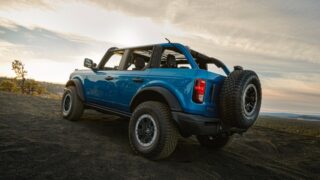|
2002 FORD EXPLORER: A NEW LEVEL OF SAFETY,
COMFORT, ROOMINESS AND VERSATILITY
Overview
“The Ford Explorer redefined the sport utility segment and
pioneered the way for the entire industry when it was introduced in
1990. For more than 10 years running, Explorer has been the
best-selling SUV in the world. But we’re not resting on our
laurels. The all-new Explorer for the 2002-model year continues to
innovate – with technological improvements in safety, roominess,
ride and comfort, all intended to lead the industry into the
future.”
– Jim O’Connor,
Ford Division President
- All-new vehicle with improved package, ride, comfort, safety
and design
- 2.5-inch wider stance and 2-inch longer wheelbase than prior
model for improved appearance, handling and roominess – while
maintaining the same vehicle length and height
- New independent rear suspension, allowing for an additional
third-row seat, seven-passenger seating capability, and improved
ride and handling
- Larger door openings and lower step-in height for better ingress
and egress
- Optional adjustable pedals, a tilting and telescoping steering
wheel and Reverse Sensing System offer better driver comfort and
convenience
- Improved Control Trac four-wheel-drive system
- Better off-road capability with increased ground clearance and
better approach and departure angles
- New all-aluminum 4.6-liter SOHC V-8 engine joins the improved
4.0-liter SOHC V-6
- New automatic and manual transmissions
- New side-impact curtain air bag system (available from launch),
as well as rollover protection sensors (available later in 2001)
- New AdvanceTrac interactive vehicle dynamics system
combines the benefits of traction control and electronic stability
(yaw) control (available later in 2001)
- Ford Personal Safety System, including driver and passenger
dual-stage air bags and deployment characteristics (available later
in 2001)
- Lower front bumper helps ensure better SUV compatibility with
other vehicles on the road
- Substantially stiffer bodyshell and thousands of noise control
measures for better NVH
- 15-percent reduction in annual operating costs thanks to easier
serviceability and longer intervals between scheduled
maintenance
The 2002-model Ford Explorer is the next generation of the
best-selling sport utility vehicle in the world. The new Explorer
is redesigned from the ground up – with major improvements in
package, suspension, powertrains and safety.
With a new independent rear suspension (IRS)_system and unique
“porthole-in-frame” design – allowing for a lower step-in height and
a third-row seat – Explorer is designed to offer an improved ride
and a more comfortable, user-friendly package. The Control Trac
four-wheel-drive system provides exceptional performance on and off
the pavement. New AdvanceTrac interactive vehicle dynamics,
available later in 2001, combines sophisticated electronic braking
and traction control with electronic stability control, to help the
driver maintain confidence and control in many driving
situations.
A sophisticated new all-aluminum V-8 engine brings 240 horsepower,
an increase of 25 horsepower over the previous V-8.
Inside, Explorer’s passengers have more room to spread out. The
passenger compartment is two inches wider compared with the previous
model and, for the first time, has an optional third row of seating
– enough overall room to accommodate seven adults.
These benefits were made possible by Explorer’s 2.5-inch wider
track and efficient packaging of the new independent rear
suspension. The second- and third-row seats also fold down to
create a flat-surfaced cargo area. Additional storage is located
beneath the rear cargo floor.
Explorer offers one of the most comprehensive safety and security
packages available. This includes Ford’s new industry-leading
Safety Canopy, which includes side-curtain air bags (available at
launch) and rollover protection (available later in 2001).
Package and Ergonomics
Access to Explorer’s new third-row seat is made easier with
one-handed controls that fold the second-row seat completely out of
the way for entering or exiting the third row.
In seven-passenger models, the second-row seat is split 40/20/40.
This configuration offers ease of access to the third row and the
ability to customize the cargo area for long or odd-sized items.
In addition, small items easily can be loaded through a new rear
liftglass, which has been designed to allow a liftover height that
is virtually identical to that of a shopping cart for easier loading
of groceries and cargo. The liftglass section no longer needs a
handle to open. It opens with a touch of a dedicated button on the
key fob, while leaving the passenger doors locked.
Ergonomics and functionality are at the heart of many of the
vehicle’s design features. For example, full-grip exterior door
handles replace the former fingertip paddles – to aid ease of use
for all passengers. Optional running boards are wider to provide a
confident step-in point.
Inside, the most frequently used controls, such as radio buttons,
are in the driver’s line of sight. Likewise, the optional
electronic message center is mounted high, for ease of use. Even
the coat hooks have been redesigned to accommodate wider, plastic
clothes hangers.
Driving Dynamics
Explorer’s new fully independent suspension and exceptionally
stiff frame – 350-percent stiffer than the previous model without
compromising safety – give it firm, responsive road manners.
In abrupt maneuvers, such as dodging a pothole or making a sudden
lane change, Explorer is designed to track precisely, without
excessive body roll. The independent rear suspension soaks up road
imperfections better than traditional solid axle designs, to provide
a comfortable, more car-like ride.
The rear-end differential in Explorer’s independent rear
suspension is mounted high in the frame rather than bolted below it.
The suspension’s upper and lower control arms also are mounted above
and below the frame. The right and left rear half-shafts pass
through a porthole in the frame rails – giving Explorer its
“porthole-in-frame” design. Together, these solutions allowed
engineers to add the new suspension system without raising the ride
height while improving the vehicle’s 4×4 ground clearance.
All four wheels are controlled by coil-over-shock assemblies that
are isolated from side loads, and are engineered to reduce unsprung
weight – for best response to steering input and road surface
irregularities.
Off pavement, Explorer’s optional Control Trac
four-wheel-drive system has been refined with stand-alone electronic
controls and enhanced software strategy that improve its ability to
handle rough or loose surfaces, such as back trails, deep snow or
sand. The system gives drivers the option of automatic four-wheel
drive or push-button, switchable, four-wheel “high” and four-wheel
“low” settings.
Explorer comes with a choice of two engines. The standard engine
is an improved 4.0-liter SOHC V-6, which generates 210 horsepower
and 250 foot-pounds of peak torque.
A more powerful 4.6-liter V-8, with all-aluminum construction and
overhead-cam design, is optional. The sophisticated engine, with
coil-on-plug design, offers 240 horsepower and 280 foot-pounds of
torque – and is designed to go 100,000 miles before its first
scheduled tune-up under normal driving conditions with routine fluid
and filter changes.
Both engines meet Low Emissions Vehicle (LEV) standards. Fuel
economy has been held constant – even with a larger vehicle and one
that can seat two more passengers than the prior model – thanks to
several weight-saving innovations. An all-aluminum hood and V-8
engine block as well as a magnesium cross beam contributed to a
90-pound weight savings.
Later in 2001, Explorer will offer flexible fuel capability with
the standard 4.0-liter V-6 engine and automatic transmission. The
Explorer flexible fuel vehicle (FFV) can operate on gasoline or a
blend of gasoline and ethanol. The use of E85 fuel reduces carbon
dioxide emissions by as much as 20 percent, compared with
gasoline.
Towing capability comes built-in. The standard receiver hitch,
which is part of the rear frame, offers Class II towing capacity of
up to 3,500 pounds, depending on engine and drivetrain.
A built-in hitch receiver offers towing capability right from the
factory and can accept many accessories, such as a bicycle rack. An
upgraded towing package, which includes a limited slip rear
differential, provides Class III/IV towing capability of up to 7,300
pounds.
Safety, Security and Convenience
Explorer is Ford’s first SUV with new side-curtain air bags.
They deploy from the headliner across approximately 75 percent of
the side glass area to help protect first- and second-row occupants
in the outboard seating positions during a side-impact collision.
Electronic rollover sensors will be available later in 2001.
They measure whether the vehicle is tilting, how fast the lean angle
is changing, and whether the combination means the vehicle might
roll over. If a rollover situation is determined by the system, it
deploys the side-curtain air bags to help prevent passengers from
being ejected from the side of the vehicle. The air bags remain
inflated for up to 6 seconds – far longer than conventional air bags
– to provide additional protection.
Explorer also is Ford’s first SUV with AdvanceTrac
interactive vehicle dynamics (available later in 2001).
AdvanceTrac is a computer driven system that uses a series of
sensors to measure whether the vehicle has begun to slide, then
applies braking selectively to whichever wheel will bring it back
under control. The idea is to prevent accidents before they happen.
AdvanceTrac is completely integrated into the vehicle’s
antilock braking system (ABS) and electronic brake force
distribution (EBD). This means that Explorer’s control system will
be just as effective off-road as it is on the pavement.
Explorer will have ABS and EBD from the start of production. The
fully integrated AdvanceTrac system will be available later in
2001.
Second-generation front air bags also are standard for the driver
and passenger, and Ford’s Personal Safety System will be available
later in 2001. The Personal Safety System uses dual-stage driver
and front passenger air bags that deploy differently based on
several factors, including the severity of the crash, front seat
occupant safety belt usage and the driver’s seat position.
Front row occupants also benefit from safety belts with
pretensioners that tighten the safety belts in the first moments of
a crash and an energy management system that slowly pays out safety
belt webbing during an incident – to help prevent injuries. Anchors
in all second- and third-row passenger positions offer secure
attachments for child safety seat tethers.
These active protection systems augment Explorer’s robust fully
boxed frame, which was designed with energy-absorbing crush zones in
the front rails. Steel bars inside the doors enhance protection in
side impacts. Head restraints in all seating positions help reduce
the risk of neck injuries.
At the same time, the design team made Explorer more friendly to
other vehicles on the road by lowering its bumper beam height 65
millimeters – more than 2 inches – to be on par with most passenger
cars.
Security features include Ford’s SecuriLock passive
antitheft system. Only users with the vehicle’s authentic key –
which contains a computer chip embedded in it – can start the
vehicle.
A battery saver feature automatically turns off interior,
courtesy and cargo lights approximately 10 minutes after the
ignition key is turned off and the last door is closed.
For better driver comfort – particularly for very tall or shorter
stature drivers – power adjustable accelerator and brake pedals are
available, while the Reverse Sensing System is available as a
parking aid. Explorer’s steering wheel tilts and telescopes, using
a single control lever.
New dual-zone climate controls are available, as is an auxiliary
climate control system for the rear seating area.
Vehicle serviceability also has been improved. Explorer’s annual
estimated service costs improve nearly $100 compared with the
previous model.
To help reduce its impact on the environment, Explorer is an
estimated 90-percent recyclable by weight. More than 10 percent of
its plastic parts contain post-consumer recycled material. Explorer
production will use an estimated 6.3 million pounds of recycled
non-metallic parts inside the vehicles every year.
Design
Explorer is designed to be rugged and contemporary to complement
the Ford “Outfitters” SUV family. The SUV family includes the Ford
Escape, Explorer Sport, Explorer Sport Trac, Expedition and
Excursion. The new four-door Explorer has a clear, powerful vehicle
stance and proportions enhanced by simple, rounded forms that build
on the vehicle’s classically popular design theme.
In many areas, form meets function. The exterior door handles
are not only easier to use, they’re rugged, big and strong. The
available running boards are wide and substantial. The jewel-like
complex reflector headlamps provide better lighting.
In the back, the rear bumper does not appear to be “bolted on”
but is fully integrated into the body and has a full-width shelf for
easier loading and unloading.
The exterior is designed to accentuate the vehicle’s independent
rear suspension and under-the-skin capabilities. The wider track is
designed to give Explorer a more aggressive stance. The shorter
front overhang helps make the vehicle look more nimble, while
improving its approach angle in rough or steep terrain.
Explorer is available in four trim levels, including the popular
Eddie Bauer, Limited, XLT and XLS.
Noise, Vibration and Harshness
Explorer’s revised body shape, coupled with improved sealing and
literally thousands of noise-control measures, result in a
substantially quieter cabin for passengers. Key to the improved
sound quality is Explorer’s new, fully boxed frame, which improves
rigidity, vehicle responsiveness and, in turn, noise, vibration and
harshness (NVH) levels.
Explorer’s frame is 350 percent torsionally stiffer and 26 percent
improved in vertical and lateral bending – which contribute to the
vehicle’s improved NVH levels. In addition, Explorer has new
micro-cellular body mounts, new door and hidden liftgate edges, new
engine, transmission and exhaust mounts, a revised engine intake
system, added insulation throughout the vehicle, a laminated steel
dash with magnesium cross bar and a 50-percent reduction in air
leakage – all of which add up to luxury-vehicle-like quietness and
NVH levels.
The Market
The SUV market has shown the most significant growth of the
decade in the automotive industry. In fact, since 1991, annual
sales of sport utility vehicles in the U.S. have grown from 900,000
to 3.2 million units through the end of calendar year 1999. It is
the only market segment that has experienced double-digit sales
growth every year during this period.
The Ford Explorer has led that growth. The Explorer is the
best-selling sport utility vehicle on the market and has been since
its introduction in 1990 as a 1991 model. It also has been among
the top-10 best-selling vehicles – car or truck – since it was
introduced. In 1998 and 1999, the Explorer nameplate enjoyed record
sales of more than 431,000 and 428,000 units respectively. It is
well on its way to another record-setting sales year in 2000.
More than 3.6 million Ford Explorers have been sold since its
introduction, so it is no surprise that there are more Explorers on
the road today than any other sport utility vehicle. Explorer also
ranks very high in customer satisfaction and loyalty.
As the sales leader, it attracts a broad range of consumers with
varying demographics and interests – from single, young
professionals to active retirees and empty nesters. They choose
Explorer because it offers rugged, functional capabilities and
sporty up-to-date styling and comfort.
Explorer often is considered the “pioneer” of the SUV market. While
it was not the first SUV, it marked the transition of the utility
vehicle from a specialized functional truck to a comfortable,
versatile activity vehicle.
Available in dealerships beginning in early 2001, the 2002-model
Explorer will be built at Ford Motor Company’s Louisville, Ky., and
St. Louis, Mo., assembly plants. Production begins in late 2000.
|




